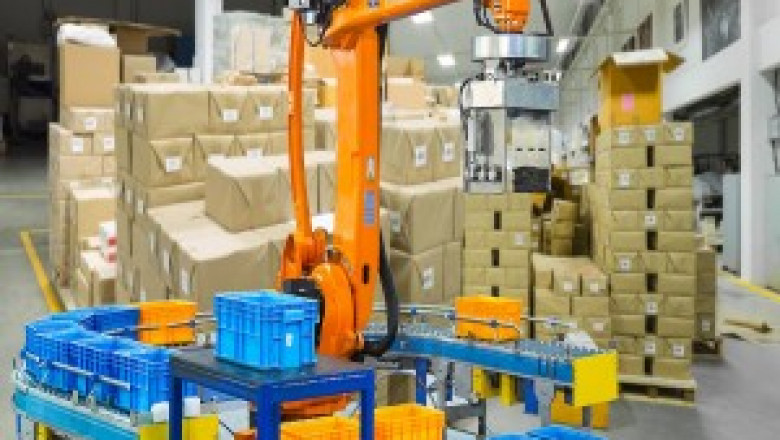views
Material handling involves the movement, storage, protection and control of materials and products throughout the process of manufacturing, distribution, consumption and disposal. It is a crucial operation within every supply chain and logistics network as it directly impacts the efficiency, costs and safety of internal processes. A wide range of material handling equipment is used to automate and streamline the transfer of goods between different locations and stages of production and distribution.
Conveyors: A Transportation Backbone
Conveyors are among the most common types of Material Handling Equipment used across industries. They provide a continuous flow of materials and parts within manufacturing facilities and distribution centers in a controlled manner. Different types of conveyors include belt, roller, slat, chain, overhead, etc and are designed according to parameters like load capacity, speed, type of material handled. Conveyors help transport materials over short and long distances both horizontally and vertically in high volumes. They link various manufacturing machines, assembly lines, packing areas and more with minimal manual intervention. This reduces product damage and enhances throughput.
Lifting and Positioning with Cranes
Cranes are critical for lifting and maneuvering heavy payloads within limited spaces both outdoors and indoors. Different types of cranes include overhead cranes, gantry cranes, jib cranes, wall mounted cranes, etc. They allow precise vertical and horizontal positioning of loads during processes like palletizing or positioning loads onto conveyors or truck beds. Cranes enable heavy items to be lifted safely and placed in confined storage areas without wasting space. This consolidates the storage process. Cranes protect workers from injuries caused due to manual lifting of heavy loads. They minimize ergonomic risks.
Warehouses Depend on Forklifts
Forklifts are the backbone of material movement in large warehouses and distribution centers. They have powerful drive motors and forks to effortlessly lift and transport pallets and containers filled with goods. Different fork trucks ranging from manual pallet jacks to rugged reach trucks and tow tractors are designed for different load capacities and environments. Forklifts can traverse long distances transporting multiple loads quickly within warehouses. They optimize space utilization by precisely positioning loads during put away and retrieval operations. This high efficiency maximizes inventory turns and throughput for the distribution operation.
Automated Guided Vehicles for Lights-Out Operations
Automated Guided Vehicles or AGVs are driverless robots that transport materials in manufacturing facilities and warehouses through pre-programmed paths. Powered by batteries and localized beacons or magnets embedded in the floor, AGVs autonomously load and unload machines, stock shelves and report inventory levels with minimal human intervention. This allows 24/7 ‘lights-out’ operations. AGVs enhance workflow consistency, optimize production schedules through accurate transfers and reduce accidents caused due to faulty human judgment or errors. They integrate seamlessly with plant information systems to streamline material and information flow.
Unit Load Assembly systems
Unit load assembly systems comprising automated machines like palletizers and depalletizers play a key role in structuring loads for optimum space utilization during storage and transportation. Palletizers suck and layer goods received in live bottom trailers or conveyors onto pallets or wooden sheets in a pre-programmed pattern. Depalletizers then break down such unitized loads back into individual items for picking. Such systems are designed to quickly assemble loads of consistent dimensions suitable for trucks, containers and racks. They enhance productivity and scalability of order fulfillment operations in factories and distribution centers.
Automated Storage and Retrieval Systems
To maximize inventory turns within limited floor area, automated warehouses rely on innovative high density storage systems. Automated Storage and Retrieval Systems or AS/RS comprise densely packed racks up to 10 meters high accessed by computer controlled shuttles and cranes. Goods are precisely stored and retrieved from three dimensional racks with narrow aisles. AS/RS organize randomly inbound and outboundSKUs better than conventional racks, with capacities up to 100,000 storage locations in the same footprint. Such vertical carousels improve space utilization by over 300% and retrieval accuracy by eliminating human errors. They are indispensable as e-commerce order volumes grow.
Care of Material Handling Equipment Critical
To extract optimal performance from material handling equipment over their functioning life, periodic maintenance and calibration assumes significance. This involves scheduled replacement of wear parts, lubrication, software updates and physical checks for functionality and compliance to safety standards. Preventive maintenance routines help identify impending faults at an early stage and prevent breakdowns that can severely impact production. Proper operating procedures and operator training further minimize damage due to misuse. Investment into condition monitoring technologies for critical assets like conveyors helps achieve predictive maintenance by remotely tracking equipment health. This boosts mean time between failure and overall equipment effectiveness of material handling operations.
Resources – How to Choose the Right Material Handling Equipment for Your Business Needs
"Types of Material Handling Equipment and Their Applications in Various Industriesâ€
Latest Development in Material Handling Equipment Market
Get This Report in Japanese Language:
Get This Report in Korean Language:
About Author:
Priya Pandey is a dynamic and passionate editor with over three years of expertise in content editing and proofreading. Holding a bachelor's degree in biotechnology, Priya has a knack for making the content engaging. Her diverse portfolio includes editing documents across different industries, including food and beverages, information and technology, healthcare, chemical and materials, etc. Priya's meticulous attention to detail and commitment to excellence make her an invaluable asset in the world of content creation and refinement. (LinkedIn- https://www.linkedin.com/in/priya-pandey-8417a8173/)






















Comments
0 comment